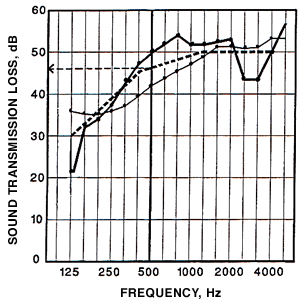Resonant Frequencies |
| When sound waves strike
a wall assembly for example, the sound is comprised of a wide spectrum
of frequencies. The wall may react to the various frequency energy in
different degrees, based on the characteristics and component make up
of the wall. The accompanying diagram depicts 2 walls, one an 8” concrete block wall and the other a steel stud and gypsum board wall. Each have the same single STC value of 47 but they each have different sound isolation characteristics. The drywall stud wall does not perform as well at the low frequencies compared to the block wall. While the block wall does not provide as high isolation at the mid range frequencies it maintains a fairly uniform increase in performance across the entire frequency spectrum. Note the drop in performance of the drywall partition between 2000 Hz and 4000 Hz. This drop is known as the “coincidence dip” which reflects the resonant frequency of the wall assembly. Rather than rely on a single number STC rating, it can often be useful and more effective to look at the total performance data and select a wall, floor or ceiling assembly that will provide the most effective performance based on the anticipated sound generated through the structure. Different structures or construction assemblies have different resonant frequencies  ––––––––– Metal stud
– gypsum board
––––––––– Metal stud
– gypsum board––––––––– 8 inch concrete block wall |